继续为大家呈现ISSCC 2011上的最新技术,包括TI能量采集芯片、IMEC医疗电子设备、支持铜线与光纤通信的以太网芯片、Dialog的低失真音频芯片、PCIe新应用领域成果,以及无需滤波器的手机SoC。
7. TI能量采集芯片
德州仪器(TI)的德国设计团队工程师Michael Zwerg,介绍了一款内置FRAM的16位微控制器;该芯片能与能量采集(energy-harvesting)装置搭配使用,可以随时储存电流。这主要是因为该组件内置了FRAM,不需要像其他内存那样在启用前需要采用一个电荷泵(charge pump)。
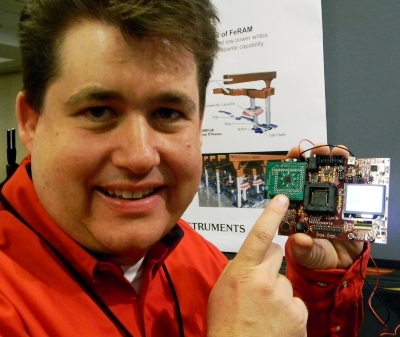
支持能量采集的TI芯片
{pagination}
8. 设计美观的医疗电子设备
下图为一款同样由IMEC所研发的最新版人体局域网络集线器(body area network hub),这款项链式的设备采用IMEC自主开发的2.4GHz收发器,功耗仅850微瓦(microwatts)。该设备可链接至记录健康数据的各种减重或是各种医疗应用的传感器,未来新一代的系统将采用IMEC与NXP共同开发、采用后者CoolFlex系列芯片为基础的生物医疗应用处理器。
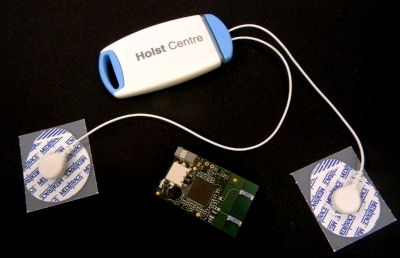
设计美观的医疗电子装置
{pagination}
9. 支持铜线与光纤通信的以太网芯片
来自NetLogic Microsystems的资深混合信号设计工程师Halil Cirit,展示了一款40纳米的10 Gbit/s以太网络芯片,可支持10GBase-KR铜线或是SFP+光纤通信。这款低抖动(low jitter)芯片目前已经开始量产。
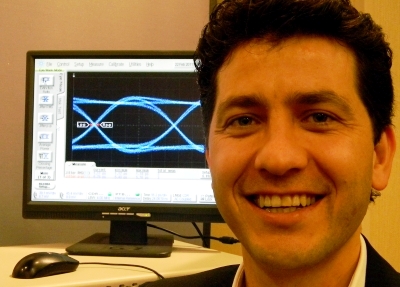
支持铜线与光纤通信的以太网络芯片
{pagination}
10. Dialog的低失真音频芯片
Dialog Semiconductor展示了一款Class D音频放大器,THD+N仅0.0012;该公司资深设计工程师Mykhaylo Teplechuk在ISSCC现场介绍,这款芯片将进驻新一代的MP3播放器。
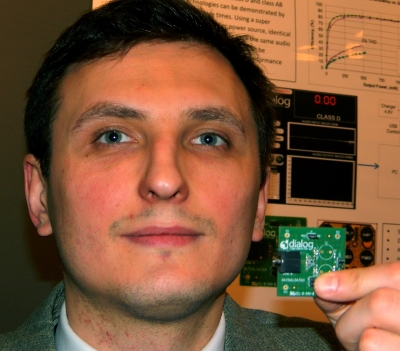
Dialog的低失真音频芯片
{pagination}
11. 日本研究人员试图将PCIe推向新应用领域
日本筑波大学研究人员Taisuke Boku(图左)与瑞萨(Renesas)的一位部门经理Hiroyuki Kondo,共同展示双方合作开发项目成果,旨在将PCI Express(PCIe)推向新的应用领域;他们所展示的SoC原型,在单个交换器芯片中整合了4个PCI e Gen 2连结,以及8个瑞萨处理器核心。
此研发成果的创新之处在于能让两颗CPU共同合作,突破了传统PCIe仅能与单一主处理器连结的限制;而这也为更多新的通信与汽车系统应用开启了可能性,因为该解决方案性能优于采用以太网络或是CAN交换器,成本又低于采用Infiniband的方案。
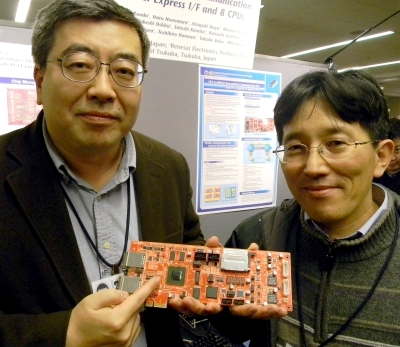
新一代PCIe解决方案
{pagination}
12. 无需滤波器的手机SoC
联发科在ISSCC也展示了一款GSM/EDGE手机应用的单芯片接收器,号称不需要外部的SAW滤波器,可简化手机电路设计。
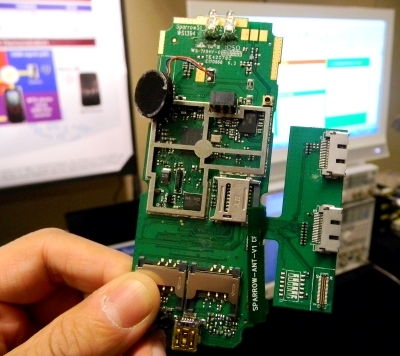
不须滤波器的手机SoC
翻译:Judith Cheng
点击进入参考原文:Photo gallery: Eye on innovations at ISSCC
《电子工程专辑》网站版权所有,谢绝转载
{pagination}
7. TI chip helps harvest energy
Michael Zwerg, a design engineer for Texas Instruments in Germany, described a 16-bit microcontroller with 16 Kbytes of embedded FeRAM. The chip is designed as a counterpart to energy-harvesting devices because it can help store current whenever it becomes available, thanks to the fact FeRAM, unlike other memories, does not need to use a charge pump before it is ready for use.
8. Medtech necklace a real jewel
Belgium's Imec research institute showed the latest version of its body area network hub. The necklace uses a new Imec 2.4 GHz transceiver that consumes just 850 microwatts, replacing an off-the-shelf Nordic radio.
The device links to sensors to record health data for fitness or medical applications. The next-generation system will use an Imec biomed processor in development with NXP based on NXP's CoolFlex chip.
Medical electronics was a big focus at ISSCC this year with its theme of "Electronics for Healthy Living."
9. Net chip handles copper, optics
Halil Cirit, senior mixed-signal design engineer at NetLogic Microsystems, shows the clean eye his 40nm, 10 Gbit/s Ethernet chip can deliver over either 10GBase-KR copper or SFP+ optical links. The market for 10 Gbit/s Ethernet is just starting to take off amid a transition from optical-only to a mix of optical and copper cables. The low jitter chip described at ISSCC is already in production.
10. Dialog cleans up audio
A Class D audio amplifier from Dialog Semiconductor delivers 3.6W of audio out at 0.0012 percent THD+N. Senior design engineer Mykhaylo Teplechuk shows the 4 milliamp chip he described at ISSCC which could power your future MP3 player.
11. Duo drives PCIe innovation
Taisuke Boku of the University of Tsukuba (left) and Hiroyuki Kondo, a Renesas department manager, were among the collaborators on a research project that drives PCI Express into a new role. Their prototype SoC integrates four PCIe Gen 2 links and eight Renesas processor cores in a single switching chip.
Their innovation: The chip can address two CPUs as peers, breaking the traditional PCIe limit of only linking to a single master processor. The fresh approach opens up new possibilities for a wide range of communications and automotive systems with an approach more powerful than an Ethernet or CAN switch and less costly than one based on Infiniband.
12. Cellular SoC saws off filters
MediaTek described at ISSCC a single chip receiver for GSM/EDGE cellular handsets. It eliminates the need for four external SAW filters, opening the door to simpler cellphone designs. MediaTek is one of many companies trying to simplify silicon and systems for emerging markets in China and around the world.